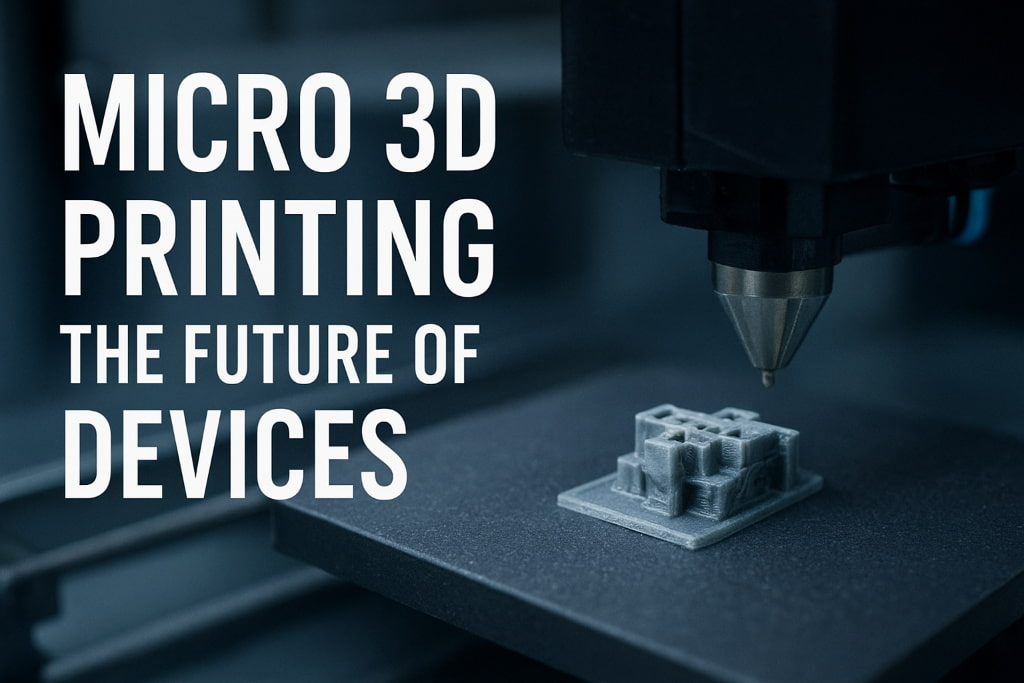Imagine holding a device so small it fits on the tip of your finger — yet it has the power to change industries, save lives, and push technology beyond its limits.
Welcome to the world of Micro 3D Printing, where tiny prints are creating a huge impact. From next-gen medical implants to ultra-thin electronics, this technology is rewriting the rules of innovation.
What is Micro 3D Printing?
Micro 3D printing is the art of creating extremely small and precise 3D objects, often measured in microns (a micron is one-millionth of a meter). Unlike regular 3D printing that makes phone cases, furniture prototypes, or large models, micro 3D printing focuses on miniaturization and accuracy.
Think of it as sculpting the invisible — building tiny structures with unmatched detail and functionality.
Why Micro 3D Printing is a Game-Changer
- Unmatched Precision – It allows the creation of components with dimensions thinner than a strand of human hair.
- Complex Geometries – Designs impossible with traditional manufacturing can now be printed layer by layer.
- Customization – Each part can be tailored to specific patient needs, product functions, or research goals.
- Efficiency – Less waste of material, faster prototyping, and better cost-effectiveness for small-scale parts.
Micro 3D Printing in Medicine
One of the most exciting uses of micro 3D printing is in healthcare. Imagine doctors being able to create tiny medical devices tailored exactly to a patient’s body.
- Custom Implants: Dental screws, stents, and hearing aid components designed with perfect precision.
- Drug Delivery Systems: Microscopic capsules that release medicine directly into the body at the right place and time.
- Tissue Engineering: Tiny scaffolds where living cells can grow — a step closer to printing organs.
This technology isn’t just futuristic — it’s already saving lives today.
Micro 3D Printing in Electronics
In electronics, smaller means smarter. Devices are shrinking, but their capabilities are growing.
- Micro-Sensors: Used in wearables, smart medical devices, and IoT gadgets.
- Circuitry Components: Ultra-compact circuit boards for faster, more efficient devices.
- Optical Devices: Tiny lenses and light guides that power advanced cameras and communication tools.
Imagine your next smartphone being lighter, thinner, and more powerful — thanks to micro 3D printing.
Other Fascinating Applications
- Aerospace: Ultra-light components for satellites and drones.
- Research: Scientists can print micro-labs for experiments at a scale never seen before.
- Energy: Tiny batteries and energy storage devices.
It’s a world where “small” doesn’t mean weak — it means revolutionary.
Challenges of Micro 3D Printing
Like any breakthrough technology, there are hurdles:
- High Costs – The machines and materials are expensive.
- Material Limitations – Not all materials can be scaled down effectively.
- Complexity – Designing at a microscopic scale requires advanced software and expertise.
But just like regular 3D printing, costs are dropping and technology is improving every year.
The Future of Micro 3D Printing
So, where are we heading?
- Personalized Healthcare: Every patient could one day receive custom-printed implants, devices, and medicine delivery systems.
- Nano-Electronics: Electronics so small they’re invisible to the naked eye but power entire systems.
- Everyday Impact: From lighter laptops to smarter wearables, micro 3D printing could become part of our daily lives.
The future isn’t big — it’s small. And it’s already here.
Where 3D Printing Meets Your World
At 3dreality, we’re passionate about bringing the latest in 3D printing to innovators, creators, and businesses.
While NASA dreams of building on Mars and scientists print devices smaller than a grain of sand, we help you harness 3D printing for prototypes, designs, and real-world solutions right here on Earth.
Whether you’re in medicine, electronics, architecture, or product design, 3D printing can turn your big (or small) ideas into reality.
Final Thoughts – Tiny Prints, Big Impact
Micro 3D printing isn’t just about making things smaller — it’s about making the impossible, possible.
From saving lives to powering the next generation of devices, this technology is proving that the future of innovation lies in the tiniest of details.
So the next time you look at your smartwatch, medical device, or even your phone, remember — the future might already be sitting right at the microscopic level.
Want to explore how 3D printing can revolutionize your projects? Visit 3dreality.in and let’s build the future together.
FAQ’s About Micro 3D Printing
Q1: What is Micro 3D Printing?
Micro 3D printing is a technology that creates ultra-small, highly precise 3D objects at the micron scale, used in industries like medicine, electronics, and research.
Q2: How is Micro 3D Printing used in medicine?
It’s used to make custom implants, drug delivery systems, micro-scaffolds for tissue growth, and components for medical devices such as hearing aids and stents.
Q3: What role does Micro 3D Printing play in electronics?
Micro 3D printing enables the creation of micro-sensors, circuit components, and optical devices, helping electronics become smaller, lighter, and more powerful.
Q4: What are the main challenges of Micro 3D Printing?
Challenges include high equipment costs, limited material options, and the complexity of designing and printing at the microscopic scale.
Q5: What is the future of Micro 3D Printing?
The future includes personalized healthcare, nano-electronics, and widespread use in everyday devices, making technology smarter, smaller, and more efficient.

